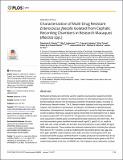| dc.contributor.author | Lebreton, Francois | |
| dc.contributor.author | Dzink-Fox, Joanne | |
| dc.contributor.author | Gilmore, Michael S. | |
| dc.contributor.author | Woods, Stephanie | |
| dc.contributor.author | Lieberman, Mia | |
| dc.contributor.author | Trowel, Elise | |
| dc.contributor.author | de la Fuente Nunez, Cesar | |
| dc.contributor.author | Fox, James G | |
| dc.date.accessioned | 2017-06-16T18:42:24Z | |
| dc.date.available | 2017-06-16T18:42:24Z | |
| dc.date.issued | 2017-01 | |
| dc.date.submitted | 2016-09 | |
| dc.identifier.issn | 1932-6203 | |
| dc.identifier.uri | http://hdl.handle.net/1721.1/109972 | |
| dc.description.abstract | Nonhuman primates are commonly used for cognitive neuroscience research and often surgically implanted with cephalic recording chambers for electrophysiological recording. Aerobic bacterial cultures from 25 macaques identified 72 bacterial isolates, including 15 Enterococcus faecalis isolates. The E. faecalis isolates displayed multi-drug resistant phenotypes, with resistance to ciprofloxacin, enrofloxacin, trimethoprim-sulfamethoxazole, tetracycline, chloramphenicol, bacitracin, and erythromycin, as well as high-level aminoglycoside resistance. Multi-locus sequence typing showed that most belonged to two E. faecalis sequence types (ST): ST 4 and ST 55. The genomes of three representative isolates were sequenced to identify genes encoding antimicrobial resistances and other traits. Antimicrobial resistance genes identified included aac(6’)-aph(2”), aph(3’)-III, str, ant(6)-Ia, tetM, tetS, tetL, ermB, bcrABR, cat, and dfrG, and polymorphisms in parC (S80I) and gyrA (S83I) were observed. These isolates also harbored virulence factors including the cytolysin toxin genes in ST 4 isolates, as well as multiple biofilm-associated genes (esp, agg, ace, SrtA, gelE, ebpABC), hyaluronidases (hylA, hylB), and other survival genes (ElrA, tpx). Crystal violet biofilm assays confirmed that ST 4 isolates produced more biofilm than ST 55 isolates. The abundance of antimicrobial resistance and virulence factor genes in the ST 4 isolates likely relates to the loss of CRISPR-cas. This macaque colony represents a unique model for studying E. faecalis infection associated with indwelling devices, and provides an opportunity to understand the basis of persistence of this pathogen in a healthcare setting. | en_US |
| dc.description.sponsorship | United States. National Institutes of Health (T32 OD010978) | en_US |
| dc.description.sponsorship | United States. National Institutes of Health (P30 ES02109) | en_US |
| dc.language.iso | en_US | |
| dc.publisher | Public Library of Science | en_US |
| dc.relation.isversionof | http://dx.doi.org/10.1371/journal.pone.0169293 | en_US |
| dc.rights | Creative Commons Attribution 4.0 International License | en_US |
| dc.rights.uri | http://creativecommons.org/licenses/by/4.0/ | en_US |
| dc.source | PLoS | en_US |
| dc.title | Characterization of Multi-Drug Resistant Enterococcus faecalis Isolated from Cephalic Recording Chambers in Research Macaques (Macaca spp.) | en_US |
| dc.type | Article | en_US |
| dc.identifier.citation | Woods, Stephanie E.; Lieberman, Mia T.; Lebreton, Francois; Trowel, Elise; de la Fuente-Núñez, César; Dzink-Fox, Joanne; Gilmore, Michael S. and Fox, James G. “Characterization of Multi-Drug Resistant Enterococcus Faecalis Isolated from Cephalic Recording Chambers in Research Macaques (Macaca Spp.).” Edited by Lynn E. Hancock. PLOS ONE 12, no. 1 (January 2017): e0169293 © 2017 Woods et al | en_US |
| dc.contributor.department | MIT Synthetic Biology Center | en_US |
| dc.contributor.department | Broad Institute of MIT and Harvard | en_US |
| dc.contributor.department | Massachusetts Institute of Technology. Department of Biological Engineering | en_US |
| dc.contributor.department | Massachusetts Institute of Technology. Department of Electrical Engineering and Computer Science | en_US |
| dc.contributor.department | Massachusetts Institute of Technology. Division of Comparative Medicine | en_US |
| dc.contributor.department | Massachusetts Institute of Technology. Research Laboratory of Electronics | en_US |
| dc.contributor.mitauthor | Woods, Stephanie | |
| dc.contributor.mitauthor | Lieberman, Mia | |
| dc.contributor.mitauthor | Trowel, Elise | |
| dc.contributor.mitauthor | de la Fuente Nunez, Cesar | |
| dc.contributor.mitauthor | Fox, James G | |
| dc.relation.journal | PLoS ONE | en_US |
| dc.eprint.version | Final published version | en_US |
| dc.type.uri | http://purl.org/eprint/type/JournalArticle | en_US |
| eprint.status | http://purl.org/eprint/status/PeerReviewed | en_US |
| dspace.orderedauthors | Woods, Stephanie E.; Lieberman, Mia T.; Lebreton, Francois; Trowel, Elise; de la Fuente-Núñez, César; Dzink-Fox, Joanne; Gilmore, Michael S.; Fox, James G. | en_US |
| dspace.embargo.terms | N | en_US |
| dc.identifier.orcid | https://orcid.org/0000-0002-2993-5198 | |
| dc.identifier.orcid | https://orcid.org/0000-0001-9307-6116 | |
| mit.license | PUBLISHER_CC | en_US |
